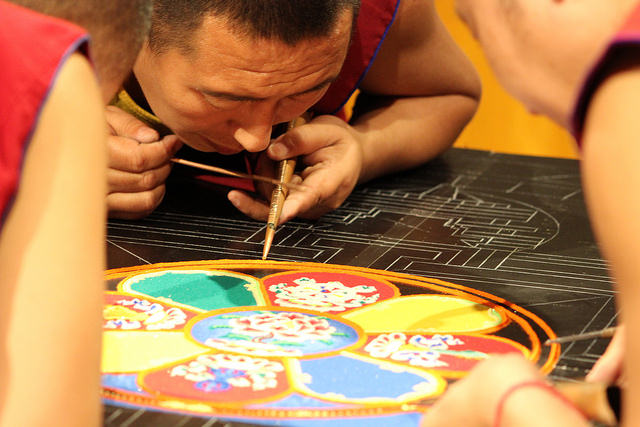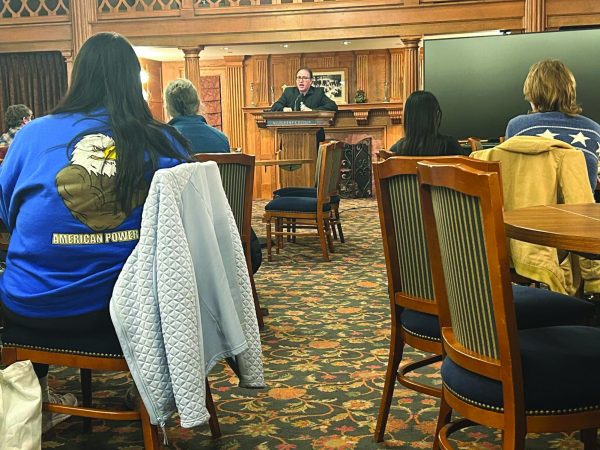Tibetan Monks create sand mandala for ‘Year of Mindfulness’
Seven Buddhist monks from the Drepung Loseling Monastery in South India visited Allegheny College from Monday, Feb. 27 to Sunday, March, 4. The monks are touring with The Mystical Art of Tibet world tour and visited the college to demonstrate and create a traditional sand mandala. The event was in association with the Year of Mindfulness and was funded by the Harry C. Winslow and Madleine King Winslow Ecumenical fund.
The monks held an official opening ceremony on Tuesday, Feb. 28, in the Bowman Penelec Megahan Galleries in the Doane Hall of Art, where they blessed the room before they began their creation. They then worked meticulously until Saturday, March 4 to create a mandala that was “compassion” themed. A student intern for the Year of Mindfulness named Nadiya Wahl, ’17, said she felt the theme of compassion was fitting given the current climate of the world.
“We figured compassion would be a good one to evoke,” Wahl said.
As well as the official mandala the monks created, there was a community mandala, designed by Wahl, that community members could work on to experience the process and learn the techniques behind creating a sand mandala. Wahl said the community mandala was so popular that it was completed by the end of the second day.
Zach Sucharski, ’19, helped Wahl run the community sand painting and said that many people — before trying it themselves — could not fathom how the monks could concentrate for so long on the mandalas and were afraid to try it in case they messed up; however, after teaching them how to do it themselves, Sucharski said almost everyone talked about how relieving and therapeutic it was.
Sucharski said that when he first tried it himself, he could not put the tools down for two hours. He then spent as much time as possible in the gallery and with the monks in the following days.
“I felt like anywhere else I was on campus, while knowing that they were here between 10 and 6 p.m., I just kind of didn’t feel right where I was, and I would usually leave whatever I was doing and walk to the campus center,” Sucharski said. “I couldn’t get [there] fast enough usually. My feet couldn’t move fast enough underneath me until I could finally get to the art gallery and breathe again.”
One thing that Sucharski said most people talked about was the energy and environment in the room.
“I don’t know if it was the blessing, I don’t know if it was the calmness or just their spirituality and their energy that you could feel, but there was just a different feeling in that room,” Sucharski said.
Sucharski and Wahl both said that people asked them if the college was going to keep the mandala when the monks were done, and that they were bewildered when they told them the monks were going to destroy the mandala when they finished.
Sucharski said the concept of destroying the mandala after it is created stems from the Buddhist belief in disattachment; this is the belief in the principle of impermanence and the notion that everything that currently is will at some point not be.
“You have to really disconnect from the ideas you have that things could be permanent and basically learn how to let everything go,” Sucharski said. “What’s more perfect to symbolize that than spending 36 hours over a five-day span just to allow your final work to sit for one hour … and then destroying it in a ceremony.”
After the mandala was destroyed, half was given to the community members who attended the closing ceremony. The other half was put back into a body of water on the assumption that all bodies of water eventually lead to the ocean. Sucharski said, this is done to spread the healing and spiritual properties of the sands back to the earth and to let them spread to everyone.
“When we see art and we see something that takes so long and is so intricate, we want to make it permanent,” Wahl said. “It was such an interesting culture difference. They’re all about the process, the meditative part of it and the intention behind it is what they’re going for. They said it’s more a devotional thing than art. We see it as art, but to them it’s much more than that. It’s all about the process of making it.”
What Sucharski said surprised him the most was the light-hearted nature of the monks, despite their studious disposition and ability to focus and concentrate on the intricate details of the mandala for hours at a time.
“I was surprised with the time that I spent with them, because you think of monks being so serious at all times, and it seemed like when they weren’t serious … they were cracking jokes and just laughing,” Sucharski said. “Anytime there seemed to be more than two of them together, they seemed to be laughing all the time unless they were working.”
During the time he spent with them, Sucharski said they taught him about their life and the different rules of the life of being a monk in the monastery.
Sucharski said all of the monks were born in Tibet except one, who was born in India. Because of China’s oppression of Tibet, it is especially hard and dangerous for the monks to return home.
“It’s pretty scary. They’re basically refugees. They have to leave in the night and then walk over the Himalayas to India,” Wahl said. “Hearing about how Tibet is being infiltrated by China, we hear about that stuff … but hearing them talk about their personal stories about it was really interesting.”
Wahl said that talking to the monks was an enriching experience and it helped humanize refugees for her.
“We hear so much about all the refugee stuff all over the world, but you don’t ever really get to have contact with them, and it was really interesting … to talk to people who had been through that,” Wahl said. “They had to leave their families behind, they’re not allowed to see their families, their families can’t leave and they can’t go back … that’s how they kind of found the monastery and became monks.”
Monks’ visit to campus upsets Chinese students due to political associations
The presence of the monks on campus highlighted political tensions and the conflicting history between Tibet and China and caused some of the Chinese students to feel upset and uncomfortable.
Sen Rong, ’20, said that although as an art major he loved the art and enjoyed learning about the skills and techniques behind the sand painting, he was shocked and upset with the political side to the monks visit.
“They said Tibet is a unique country. That was awful because I am Chinese and I think Tibet is part of China,” Rong said. “It is not an arguable question for us about Tibet.”
Xingbang Liu, ’20, said that the Chinese students agree that these kind of art exhibitions should be held on campus, however without the political ramifications.
“The U.S. government agreed … that Tibet is part of China since 1979,” Liu said. “In this case they say Tibet is not part of China and ‘free Tibet’.”
Liu said it was important for people to recognize that the Chinese students do not share the same history and culture as Americans.
Tibet has been under the control of the Chinese government since 1271, according to Liu. He said in the People’s Republic of China, the central government signed a 17 point agreement for the peaceful liberation of Tibet in 1951, and in 1956, a committee — which the Dalai Lama was the chairman of — was set up to prepare Tibet to become an autonomous region. In 1959 the local Tibetan government betrayed the agreement and held an armed rebellion. The Dalai Lama then fled Tibet following this rebellion.
Liu said a couple of students reached out to Dean of Students Kimberly Ferguson and the two main organizers of the event Chaplain Jane Ellen Nickell and Associate Professor of English Jennifer Hellwarth to express their concerns about the monks’ presence on campus.
“This situation which could hurt our feelings shouldn’t exist,” Liu said. “Our main point is that we [are] not against arts and [religion], we [are] just against the politic involved in it.”
Tibetans tend to disagree with this account of history, according to Time magazine. BBC.com states that “Tibet has a tumultuous history, during which it has spent some periods functioning as an independent entity and others ruled by powerful Chinese and Mongolian dynasties.”
Tibet was an independent state from 1912 to 1950 when China enforced a long-held claim to the country and sent thousands of troops into Tibet to enforce this claim, according to BBC.com.
In 1951 Tibetan leaders were forced to sign the “Seventeen Point Agreement for the Peaceful Liberation of Tibet” which “professes to guarantee Tibetan autonomy and to respect the Buddhist religion, but also allows the establishment of Chinese civil and military headquarters at Lhasa,” says the BBC website.
The Dalai Lama fled for India and set up government there after a failed anti-China uprising in 1959. The BBC states that most of Tibet’s monasteries were destroyed in the 1960s and 1970s and that it is believed that thousands of Tibetans have been killed during periods of repression and martial law.
The Freedom House “Freedom in the World 2016” report ranked Tibet second to last with its aggregated score of political rights, civil liberties and general freedom rating, with Syria being the only country ranked lower. Tibet scored a 1 out of 100 with 0 being the worst and 100 being the best.
Since the Dalai Lama left Tibet, there have been various attempts at communication between Beijing and the Dalai Lama. No outside country openly disputes China’s claim to sovereignty over Tibet, according to BBC.com.
Xiaoyu Zhu said she understands the complex nature of situation and that not everyone will agree on what the truth is, but that the Chinese population on campus wish their opinions and feelings were not overlooked by the college.
“We are [a] minority of this school,” Zhu said. “We just want to know if that means our voice is not important.”
Zhu said the most problematic aspect of the monks visit was the “Free Tibet” flag present in the gallery during the show. She said the students intend to write a letter to the school detailing their opinions and perspective to help educate and to ensure their voices are heard.
“We don’t want to say ‘you are wrong and our opinion is right,’ we just want to let the school [hear] our voice,” Zhu said.
Medha Nag, ’20, is an international student from India who said that although she can understand the Chinese student’s sentiment, she believes Buddhism stands for peace.
“These monks — they came in and it was a very peaceful thing,” Nag said. “I feel like we shouldn’t be bringing world politics into something that’s so beautiful and so artistic and creative. Especially in our world today.”








